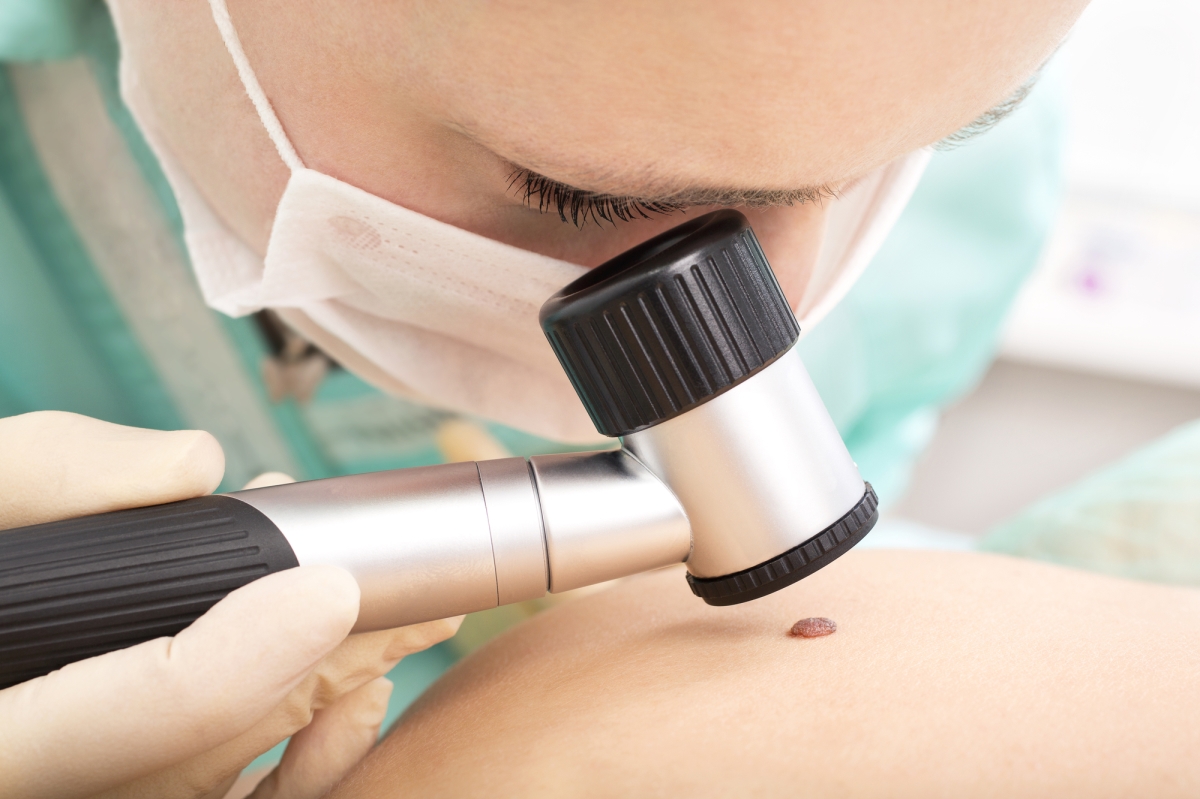Moles, also known as nevi, are a common type of skin growth. They often appear as small, dark brown spots that are caused by clusters of pigment-forming cells called melanocytes. Most people have 10 to 45 moles that appear during childhood and the teenage years. Moles can last up to 50 years.
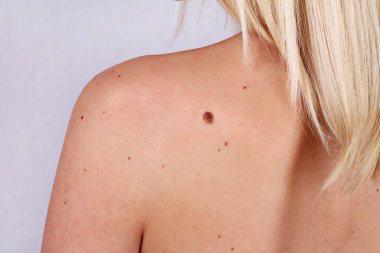
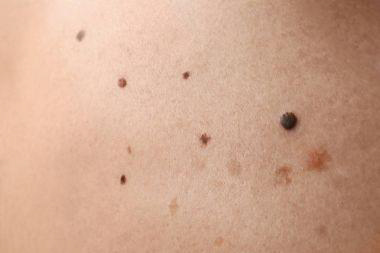
Most moles are harmless. Moles are not contagious. Rarely, they become cancerous. Being aware of changes in your moles and other pigmented patches is important to finding skin cancer, especially malignant melanoma.
Moles can grow anywhere on your body, including your scalp and armpits, as well as under your nails and between your fingers and toes. Most people have 10 to 45 moles. Many of these moles occur by age 40. Moles may change or fade away over time. They may become darker and larger with hormonal changes that occur during the teenage years and while pregnant.
Clusters of brown spots around the eyes, cheeks and nose are dermatoses papulosa nigra — a type of seborrheic keratosis that is noncancerous and appears as waxy brown, black or tan growths. They aren’t clusters of pigment-forming cells, known as nevi. Dermatoses papulosa nigra are more common among Black women. These lesions don’t carry a risk of melanoma, but they can be treated as a cosmetic concern.

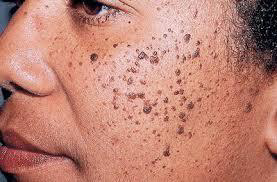
Causes: Moles are caused when cells in the skin called melanocytes grow in clusters. Melanocytes generally are distributed throughout the skin. They produce melanin, the natural pigment that gives skin its color.
The typical mole is a small brown spot. But moles come in different colors, shapes and sizes:
Color and texture: Moles can be brown, tan, black, blue, red or pink. They can be smooth, wrinkled, flat or raised. They may have hair growing from them.
Shape: Most moles are oval or round.
Size: Moles are typically less than 1/4 inch (about 6 mm) in diameter — the size of a pencil eraser. Those present at birth, known as congenital nevi, can be bigger and cover part of the face, trunk or a limb.
Types of skin moles:
Common Nevi:
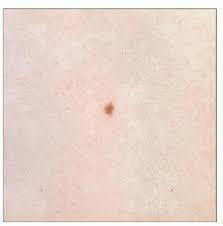
This is a normal mole, a small growth on your skin that’s pink, tan, or brown and has a distinct edge.
Congenital Nevi:
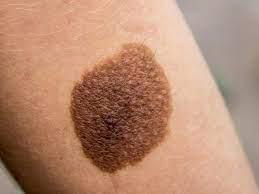
These are moles discovered on your skin when you were born. Congenital nevi occur in about one in 100 people. These moles may be more likely to develop into melanoma than moles that appear after birth. If your skin mole is more than eight millimeters in diameter, it has a greater risk of becoming cancerous.
Dysplastic Nevi:
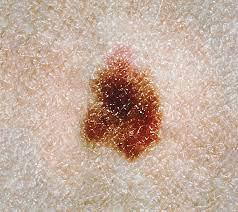
These moles are larger than a pencil eraser and irregularly shaped. Dysplastic nevi tend to have uneven color with dark brown centers and lighter, uneven edges. These moles tend to be hereditary (inherited), and people who have them may have more than 100 moles. If you have dysplastic nevi then you have a greater chance of developing malignant (cancerous) melanoma. Any changes in a mole should be checked for skin cancer by a dermatologist.
Unusual moles may indicate melanoma :
A mole may be a sign of skin cancer if it has irregular borders or an asymmetrical shape, or if it changes in color, shape, size or height. This ABCDE guide can help you remember what to watch for:
- A is for asymmetrical shape. One half is unlike the other half.
- B is for the border. Look for moles with irregular, notched or scalloped borders.
- C is for color changes. Look for growths that have changed color, have many colors or have uneven color.
- D is for diameter. Look for new growth in a mole larger than 1/4 inch (about 6 mm).
- E is for evolving. Watch for moles that change in size, shape, color or height. Also, new symptoms can arise, such as itchiness or bleeding.
Cancerous moles, also known as malignant moles, vary greatly in how they look. Some may show all of the changes listed above. Others may have only one or two unusual traits.
Melanoma is the main complication of moles. Some people have an above-average risk of their moles becoming cancerous and leading to melanoma. Factors that raise melanoma risk include:
- Being born with large moles. These type of moles are called congenital nevi. They are subclassified based on their estimated adult size. Large and giant congenital nevi that are more than 20 centimeters in diameter are at higher risk of developing melanoma.
- Having unusual moles. Moles that are large with an irregular border are known as atypical nevi, also known as dysplastic nevi. They tend to run in families.
- Having many moles. Having more than 50 moles suggests a greater risk of melanoma and possibly breast cancer.
- Having a personal or family history of melanoma. If you’ve had melanoma before, there is a higher risk of getting melanoma again. Also, some types of atypical nevi lead to a genetic form of melanoma.
- Using tanning lamps or beds. Tanning lamps and beds release UV rays and can raise your risk of skin cancer.
Moles can develop in any cutaneous (skin) or mucosal (mouth, eyes, genitals) surfaces. If you have had melanoma (or have a strong family history of melanoma), in addition to routine exams by a dermatologist, you should have annual check-ups with a dentist, ophthalmologist (eye doctor) and a gynecologist to look for moles in these special locations.
The following measures can help limit the growth of moles and the main complication of moles:
Watch for changes
Become familiar with the location and pattern of your moles. Regularly look at your skin for changes that may signal melanoma. Do self-exams of the skin monthly. With the help of mirrors, do a head-to-toe check, including:
Scalp, Palms and fingernails, Armpits, Chest, Legs, Feet, including the soles and between the toes, Genital area and between the buttocks, Protect your skin
Take measures to protect your skin from ultraviolet (UV) radiation, such as from the sun or tanning beds. UV radiation has been linked to higher melanoma risk. And children who haven’t been protected from sun exposure tend to grow more moles.
Stay out of the sun during peak times. For many people in North America, the sun’s rays are strongest between 10 a.m. and 2 p.m. Try to schedule outdoor activities for other times of the day, even on cloudy days or during the winter. When you are outdoors, seek shade or use an umbrella to protect yourself from the sun.
Use sunscreen year-round. Apply sunscreen to dry skin about 15 minutes before going outdoors, even on cloudy days. Use a broad-spectrum, water-resistant sunscreen with an SPF of at least 30. Apply it generously and reapply every two hours — or more often if you’re swimming or sweating.
Wear protective clothing. Sunglasses, broad-brimmed hats, long sleeves and other clothing can protect you from damaging UV rays. You also might want to think about clothing that’s made with fabric specially treated to block UV radiation.
Don’t use tanning lamps or beds. Tanning lamps and beds release UV rays that can raise your risk of skin cancer.
Examination of skin for moles:
Perform skin self-examinations every month. It is best if you examine your skin after a bath or shower, while your skin is still wet.
Use a full-length mirror (if you have one), as well as a hand mirror, for a closer view. Ask a family member, if available, for help for the more difficult sites, such as your back.
Try to examine yourself the same way every month to avoid missing any areas. Start at your head and work your way down. Look at all the areas of your body (including the front, backs and sides of each area, and your fingernails and toenails). Also be sure to check the “hidden” areas: between your fingers and toes, your groin, the soles of your feet and the backs of your knees.
Don’t forget to thoroughly check your scalp and neck for moles.
Keep track of all the moles on your body and what they look like. Take a photo with a ruler in it and date it. That way, you’ll notice if the moles change. If they do change in any way (in color, shape, size, border, etc.), or if you develop a sore that does not heal, you should see a dermatologist. Also have your dermatologist examine any new moles that you think are suspicious.
Treatment
Most moles don’t need treatment. If you’re self-conscious about a mole, you could try makeup to help hide it. If you have a hair growing from a mole, you might try clipping it close to the skin’s surface or plucking it. Anytime you cut or irritate a mole, keep the area clean. See your healthcare professional if a mole doesn’t heal.
You also might talk with your dermatologist about surgically removing a mole if it bothers you or if you notice suspicious changes in it. Mole removal is a quick procedure that is typically done on an outpatient basis. During mole removal, your healthcare professional numbs the area around the mole and cuts it out, along with a margin of healthy skin if needed. The procedure may leave a permanent scar. People with Black skin are at increased risk of other surgical side effects, such as pigmentary changes where the cut is, and keloid scars, which are raised scars after an injury heals.
If you notice that a mole has grown back, see your healthcare professional promptly.
Normal (benign) skin moles do not need to be removed (doing so will leave a scar).
If your dermatologist determines that the mole is a concern, he or she will perform a skin biopsy, in which a small sample of the mole is taken to examine under a microscope. A diagnosis can usually be made in less than a week. If the mole is found to be cancerous, it needs to be completely removed.

